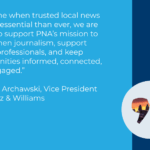 5 Questions and 6 Answers for This Moment in Fundraising
5 Questions and 6 Answers for This Moment in Fundraising
Well, it’s been two months—more or less and depending on the exact date at which life as we know it came to a stop in your part of the country. For most of the nonprofits we work with at Schultz & Williams, the initial chaos has abated somewhat. Operations are up and running virtually. The initial challenge of launching a rapid response has been met. A tenuous, new not-normal has settled in.
Even in this relative calm, however, the mid- and longer-term outlook remains uncertain in the extreme, and organizations are grappling with tough questions every day. In this piece, I share five of those questions that we have been hearing most frequently, along with our best answers. And thrown in for extra value, I end with one more response—to a question people tend not to ask, but ought to.
Question #1: Should we pause our campaign?
Unless there are clear reasons specific to your organization and donor audience, we would not recommend that you pause.
It might well, however, be necessary to rethink your timeframe, extending your end date. And you may want to consider talking with donors about the possibility of repurposing dollars already committed toward new needs, such as urgent operational priorities. Similarly, you may want to revisit the campaign funding pillars you initially announced. In these extraordinary times, donors will understand. In fact, they will appreciate your responsiveness.
If you do move forward with your campaign, however, it is essential to exercise rigorous, case-by-case care in planning how you will engage each major gift prospect, whether an individual, corporation, or foundation. This is not the time, for instance, to make a major ask of someone whose fortune is, or was, in airlines or hotels. Turn to your donor research more religiously than ever.
I should also note that the above advice is for organizations whose campaigns are already public. If you are in the nucleus phase and were due to launch publicly soon, the answer is different. You should wait. Instead, launch a campaign of cultivation, turning the resources and energy you were going to devote to meeting your historic goal into thoughtful, consistent stewardship, so that when the time is right, you and your most important prospects will be more than ready. As you communicate with donors and prospects, underscore the pivots your organization has successfully made during the pandemic. Your COVID narrative is important; donors want to know what and how you’re doing.
Question #2: Should we pause our annual fund and/or membership campaign?
No. Do not pause your annual giving program or membership campaign. Doing so would be to surrender momentum you’ve worked hard to build, to disappear from your stakeholders’ awareness, and to send an unintended message that supporting your organization is not as important as supporting all those that continue to ask.
For more on what you should be doing, I recommend “Direct Marketing in Strange Days,” a smart and very readable article by my S&W colleague, Sarah Hartke.
Question #3: How are individuals and foundations fielding requests now?
For the most part, they are maintaining their commitments to the sectors and causes they supported pre-COVID. This would be a very difficult time to cultivate a new relationship with a funder who has not previously supported your work, but it is a very important time to cultivate your relationship with anyone or any organization that has.
A few other points: Some funders may be willing to shift previously committed money to operating needs if you make a strong case. And, you need to think carefully about each donor’s priorities, interests, and present situation in framing your ask.
Question #4: Is there an appetite for virtual events?
Here the answer is a strong, but qualified, “yes.”
Organizations are hosting a variety of virtual events, and in some cases drawing audiences far larger than their traditional galas ever did. I recently “attended” an electrifying virtual jazz ensemble performance, the theme for which was “family.” In another inspiring example, a beloved museum has found success with Zoom sessions featuring their curators reading poetry—a wonderfully surprising disciplinary cross-over. And another client, whose mission is to deliver on-site, cultural programming (nine weeks of it a summer!), is now shifting the upcoming season online.
For many organizations, virtual events are not just an opportunity, but will become a necessity—one of several essential ways to engage their donor audience over the long months of separation that threaten to stretch ahead. Update emails—even compellingly worded—get dull after a while. More creative solutions are needed. An added bonus: virtual events draw new audiences who may have never engaged with your organization before.
Now for the reasons my endorsement of virtual events is a qualified one. First, while it’s clear that the right event can draw a crowd, it’s less certain that these events can raise the dollars organizations are used to. You may have to justify them as a cultivation tool, rather than as a cash stream. Second, as I suspect we’ve all discovered, virtual events only work with good content. People are still forgiving of shaky production values, but you’ve got to give them something thoughtful, or touching, or fresh to engage them—and if you don’t, they’re not so likely to give you another chance.
Question #5: How much urgency should we message in our appeals?
My best advice is to communicate urgency, but not emergency. If your organization is, in fact, in acute need, you should honestly express that need. You should also communicate your solution. If the sky is falling, let them know. Then tell them your plan for holding it up, and how their gift is going to help.
Transparency here can be a powerful tool. People committed to your mission want to understand how it’s been impacted by this crisis. If you are acting resourcefully in response, explaining that will inspire support. (Three of my S&W colleagues will be diving into this and related topics in a May 29 webinar, “How to Pivot Your Messaging in Difficult Times.”
Now, to explain my suggestion that you avoid a sense of emergency, I will share two reasons. First, donors want to invest in organizations that will ultimately succeed. Painting a picture of dire crisis won’t help. Secondly, crisis communications quickly grow fatiguing. They are not the basis for long-term and growing relationships with donors.
Bonus Answer
And now for the additional unsolicited advice I promised. It’s this: Now is actually a critically important time to focus on strategic planning.
As you think about your organization’s success and that of your fundraising, the moment-to-moment contingencies of this crisis can be all-consuming. But to be positioned for the recovery, you need to take some time away from the demands of today and think about the possibilities of the next 6-18 months.
This does not mean launching a new full-scale strategic plan, but rather re-examining your existing plans in the context of new realities. It also probably means imagining and coming to terms with multiple future scenarios. Since none of us know what the coming months hold in store, it’s essential to prepare for several contingencies. The S&W strategic planning team has been guiding clients with this kind of agile strategic visioning in some very thoughtful and resourceful ways.
So to recap, Question #6, the one that many more organizations should be asking, is whether this is the time to engage in planning. And my answer, as we all look with guarded but stubborn hope to a much better future, is, “Yes!”





